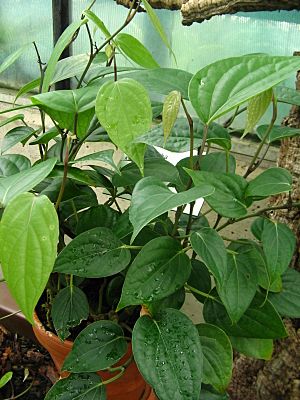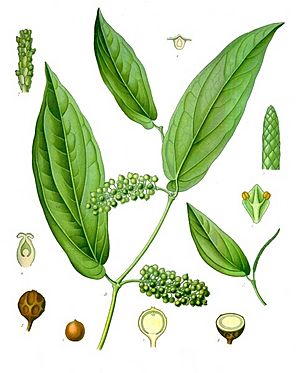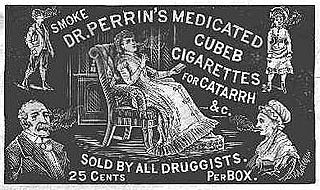Cubeb facts for kids
Quick facts for kids Cubeb |
|
|---|---|
 |
|
| Scientific classification | |
| Genus: |
Piper
|
| Species: |
cubeba
|
Piper cubeba, also known as cubeb or tailed pepper, is a special plant from the Piper family. People grow it for its unique fruit and the oily liquid that comes from it. It's mostly found growing in Java and Sumatra, which is why it's sometimes called Java pepper.
The fruits are picked before they are fully ripe and then carefully dried. When you see dried cubeb, it looks a lot like black pepper. But cubeb has a small "tail" or stalk still attached, which is why it's called "tailed pepper." The dried outer skin of the fruit is wrinkly and can be grayish-brown to black. Inside, the seed is hard, white, and oily. Cubeb has a pleasant, spicy smell and a strong, slightly bitter taste. Some people say it tastes like allspice or a mix of allspice and black pepper.
Cubeb first arrived in Europe from India, brought by Arab traders. Its name, cubeb, comes from the Arabic word kabāba. In the 1600s, the king of Portugal even tried to stop cubeb from being sold to help promote black pepper instead! Cubeb became popular again in Europe in the 1800s for its medicinal uses, but it's not widely used there today. However, it's still used to flavor gin and some cigarettes in the West. In Indonesia, it's a common seasoning for food.
Contents
History of Cubeb
People have known about cubeb for a very long time. Around 300 BC, a Greek writer named Theophrastus mentioned a spice called komakon. Experts think this might have been cubeb. This suggests that Greeks might have traded with Java even back then! Javanese farmers were very careful to protect their cubeb trade. They would scald the berries to make sure no one could grow the vines anywhere else. This helped them keep their monopoly on the spice.
In the Tang Dynasty (618–907 AD), cubeb was brought to China from Srivijaya, an ancient kingdom. In India, it was called kabab chini, meaning "Chinese cubeb." Chinese doctors used it to help people eat more, make hair darker, and even make the body smell good. But it seems cubeb was not used for cooking in China.
The famous book One Thousand and One Nights, written in the 800s, mentions cubeb as a way to help with fertility. This shows that Arabs were already using it for health reasons. By the 900s, cubeb was also used in Arabic cooking. Later, in the 1200s, Marco Polo wrote about Java being a place where cubeb and other valuable spices grew.
In the 1300s, cubeb arrived in Europe from the Grain Coast in Africa. People in Europe even believed cubeb could scare away bad spirits! A Catholic priest in the late 1600s, Ludovico Maria Sinistrari, included cubeb in a special incense used to ward off certain demons.
After the king of Portugal tried to stop its sale, cubeb was used less in European cooking. It was mainly used for medicine until the 1800s. In the early 1900s, Indonesia still sent cubeb to Europe and the United States. But after 1940, the trade almost completely stopped.
What is Cubeb Made Of?
The dried cubeb berries contain special oils. These oils are made up of different chemical compounds. Some of these are called monoterpenes, like sabinene, and others are sesquiterpenes, like caryophyllene. These compounds give cubeb its unique smell and taste.
When cubeb is distilled with water, about 15% of it turns into a volatile oil. This oil is a pale green, thick liquid with a warm, woody smell. It can also form special crystals called "camphor of cubeb."
Another important substance found in cubeb is called cubebin. It's a crystalline substance that was discovered in 1839. It can be made from the cubeb oil or from the leftover pulp after the oil is removed.
How Cubeb is Used
Traditional Medicine
In the Middle Ages, Arab herbalists often used cubeb. They called it kababa and used it in preparing special waters for health. In England, cubeb was valued for its ability to help prevent infections.
In the Kitchen
In Europe during the Middle Ages, cubeb was a valuable spice. People would grind it up to season meat or use it in sauces. There's a medieval recipe for a sauce called sauce sarcenes that includes cubeb, almond milk, and other spices. Cubeb was also often candied and eaten whole as a sweet treat. In Poland in the 1300s, a special vinegar with cubeb, cumin, and garlic was used to marinate meat. Cubeb can also make savory soups taste even better.
Cubeb reached Africa through Arab traders. In Moroccan cuisine, cubeb is used in savory dishes and in pastries like makrouts, which are small honey and date treats. It's also sometimes found in the famous Moroccan spice mix called Ras el hanout. In Indonesian cuisine, especially in dishes like gulés (which are a type of curry), cubeb is often used.
In Special Cigarettes and Drinks
Historically, cubeb was sometimes used in special cigarettes. These were not regular cigarettes, but were used to help with breathing issues like asthma, sore throats, and hay fever. The author Edgar Rice Burroughs, who created Tarzan, even joked that if he hadn't smoked so many cubeb cigarettes, Tarzan might never have existed! A popular brand of these special cigarettes was Marshall's Prepared Cubeb Cigarettes, which were sold even during World War II.
In 2000, cubeb oil was listed as an ingredient in some cigarettes by North Carolina's health department.
Cubeb is also used to flavor some alcoholic drinks. For example, Bombay Sapphire gin uses cubeb and grains of paradise for its flavor. There's also a Ukrainian drink called Pertsivka, which is a dark pepper-flavored spirit made with cubeb and other peppers.
Other Uses
Sometimes, cubeb is used to mix with or change the essential oil of patchouli. This means people who use patchouli oil need to be careful. Also, cubeb itself can sometimes be mixed with other types of pepper, like Piper baccatum or Piper caninum.
See also
 In Spanish: Pimienta de Java para niños
In Spanish: Pimienta de Java para niños




